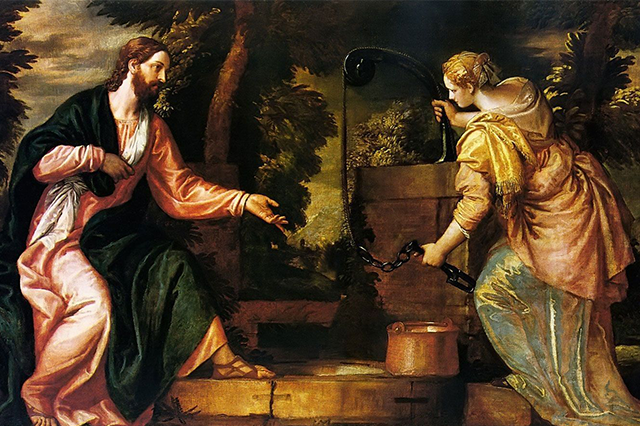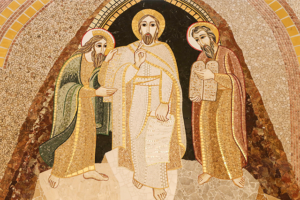Third Sunday of Lent
EX 17:3-7 PS 95:1-2, 6-7, 8-9 ROM 5:1-2, 5-8 JN 4:5-42
On this Third Sunday of Lent, the lectionary presents us with a familiar Gospel narrative, that of the woman at the well. The danger for us, who have heard the well-known Gospel stories many times before, is that they will fall flat- “I’ve heard this one… I know this.”
But the word of God is never stagnant, it is always new and always lifegiving if we have ears to hear it (Mt 13:15). This reading is truly unique in the context of encounters with Jesus. It is so dense with meaning that I found it difficult to narrow down the topic on which to write here. But I settled on one.
Many of us have heard the more common discussions of this passage in reference to Jesus crossing various boundaries here for the sake of his mission. The features of this encounter highlight this breaking of taboos. He crosses through Samaria instead of going around, via the Jordan as some scholars speculate that Jews would have done, to avoid contact with Samaritans. He speaks to an unaccompanied woman, a cultural taboo. He interacts with a Samaritan, himself being a Jew, an ethnic/religious taboo. For Jesus to share the drinking vessel with her would make him ritually unclean. Then there is the woman’s history of past marriages. None of these deter him from his encounter with her. But that reading is too middle of the road for my tastes. To aid in seeing this passage anew, I will make my point of entry to this passage, not the crossing of boundaries, but the motif of the well.
For the contemporary reader, a meeting at a well may call to mind meetings at social spaces, ‘watering holes’ so to speak. We might compare this to a meeting at a mall or grocery store, possibly at a water cooler. But the first century Jews who heard ‘a woman, a man, and a well’ would have recognized the old testament motif in the same way we recognize “a priest, a rabbi, and a politician walk into a bar…” as the beginning of a joke. John is at pains to stress this connection by setting up the scene calling to mind the patriarch Jacob who along with Isaac, Judah, and Moses each find their wife through an occurrence at a well. In the chapter preceding this one, John the Baptist elicits the language of the bridegroom in reference to Jesus (Jn 3:29). The church as bride of Christ is the metaphor par excellence throughout the New Testament through which to understand the church (Mt 9:15; Mk 2:19; Lk 5:34; Eph 5:22; 2 Cor 11:2; Rev 19:7, 2:2-9). The imagery makes clear that the encounter with the Samaritan woman is representative of the encounter of Christ with his Church.
“Eros, the passion with which God seeks us and desires for us to have life in the full…”
Jesus speaks first. It is always God who seeks his people, he thirsts for them. The living water he offers is the source of life which wells up from within. It is the dynamism of the Spirit which occurs when the word is heard and takes root. It is what gives hope to those in despair, it liberates, and leads to the transformation of the world. The image of “a spring of water welling up to eternal life” (Jn 4:14) is not merely one of supplying what is needed for life, but something more provocative. The motif relating to marriage and the well evokes a sense of desire or Eros, the passion with which God seeks us and desires for us to have life in the full. His encounter with the Samaritan woman does not just give her this living water, but also feeds Him, as indicated in a remark towards the end of the reading, when the disciples ask him to eat but he responds, “I have food to eat of which you do not know” (Jn 4:32).
The evangelist places this encounter right after the encounter with Nicodemus which serves as a parallel. They also discuss the life-giving water and spirit which Christ brings, but he responds, “how can this happen?” (Jn 3:9) The Samaritan woman, venerated as a saint in the Easter Catholic traditions, goes out and evangelizes others and brings them to the Savior. In the gospel of John, this occurs before the commissioning of the twelve, in essence making her the first apostle- one who receives the gospel and, moved by the Spirit, is sent on mission to share this with others.
As we progress in this Lenten journey and move closer to God through prayer, fasting, and almsgiving, consider the dynamic between the Samaritan woman and Jesus. Does our encounter with Christ through the word or the sacraments play out like one of these scenes at a well? Have we allowed the message of the gospel to awaken that passion within us and move us to respond like the Samaritan woman?
Image credit :Paolo Veronese: Christ and the Woman of Samaria




El agua viva que Jesus le ofrece a la samaritana me recordo que los que somos bautisados somos pribilegiados de recibir esa misma agua viva y el espiritu santo que Jesus ofrece para vivir para el y morir para el para la vida eterna.Te felicito por lo que escribiste me gusto y me ayudo a entender mas el ebanjelio de jesus y la samaritana que Dios te siga iluminando tu mente y tu Inteligencia Dios te bendiga